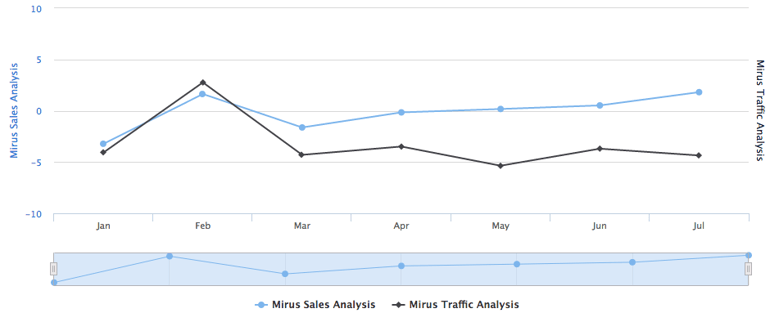
The Data Is In
The word on restaurant sales has been out in the public for a while now. Same store sales are down for many segments. And for some of the most recent months, the industry overall is down.
Two factors lead to negative same store sales: declining customer traffic, or customers spending less on each visit. It has been well documented that restaurants have been increasing their prices over the past few years. The National Restaurant Association measured price inflation at 2.7% in July 2016, while the average cost of ingredients fell -3.5%. The increased margin dollars have helped some restaurants cover the increases in labor.

The chart above shows the trend lines for the Mirus Index measurement of same store sales and customer traffic. You can see that the traffic trend is much lower than the sales trend. The gap between the two is created by either price increases, or lower average spend per check. Restaurants are keeping sales up by increasing their prices, but can this be sustained?
Macroeconomic factors can affect customer traffic. Lots of people thought that traffic would be helped by low gas prices, but of course, gas prices have been increasing for most of this year. The election year is probably having an affect on traffic for some people, but I wouldn't know how to measure if it is helpful or hurtful. Lower unemployment should also help build same store sales.
The natural competitor to all restaurants is the grocery store. If you can't afford to eat at a restaurant, you will likely eat at home. For most of the past 45 years, the restaurant industry has taken market share away from grocery stores, as measured by the sum of in-home and out-of-home food dollars. Inflation has increased the cost of meats, dairy and produce, and that inflation has been felt almost equally in the grocery and restaurant industries.
However, something has changed. Grocery prices, overall, are lower today than last year. This mostly reflects decreased pricing of meats and dairy as those industries recover from the droughts of a few years ago, and the avian flu. Fruits and vegetable prices are higher, but not enough to make up for the declines in meats and dairy. The National Restaurant Association's measurement of grocery store prices is a decline of -0.6%. If you add the price increases restaurants have imposed, you see that it is 3.3% more expensive to eat in a restaurant than to eat at home this year versus last.
If this were the only year that restaurants were going up while grocery stores were going down, it probably would not be a factor in today's market. However, this gap between restaurants and grocery stores has been going on for years. The Restaurant Finance Monitor cites a study by the American Institute for Economic Research that measured price increases for both grocery and restaurants over the past five years. The graph below illustrates their conclusion that grocery has averaged 1.8% annual increase versus 2.6% for restaurants. The cumulative effect is like compounding interest.

Restaurants have to understand that they will not be able to keep increasing prices at the same rate they have over the past several years. That is a huge problem, because without these price increases, the lower customer traffic flow will cause same store sales to go even more negative. If you imagine no price increases, the same store sales percent will equal the traffic decline percent.
I don't see an easy way out of this situation for restaurants. They have a growing price disadvantage against grocery. It will take years to reduce the gap that has been created and win customers back. On top of that, labor issues will continue to make profitability harder to manage.
Restaurants have to get customers to come back. Without a turnaround with traffic, the industry will be managing a shrinking market. In fact, it already is. According to the Mirus Index, customer traffic is down roughly -2% over the last twelve months. A more concerning observation is that for the first seven months of 2016, the same store traffic count has been less than in the corresponding months in 2012.
We have to fight grocery stores to get customers to come back to restaurants. This is a fight in the trenches, and to attract more customers to come through the door, we need to give them reasons to eat in our restaurants versus their kitchens.
Here are my 3 To-Do's to turn around restaurant sales:
- Stop the price increases.
- Use some of your improved margin dollars to clean your locations.
- Train the staff to provide the best service they can.
Stop the price increases
We can't win the customers back until we stop increasing the cost advantage that grocery currently enjoys. Since the recession we have gone to this well too many times, and the sooner we stop, the better.
Clean the locations
When you battle for customers, you have to create the best impression you can. Windows, mirrors, and oh yeah, the bathrooms. Every day. Show the customers you care enough to give them a clean place to enjoy their meal.
Train, train, train
As unemployment has been reduced, all restaurants have found it harder to hire experienced staff. The inevitable result is that many restaurants have hired staff that are less experienced. Getting your customers to come back is so much easier when they feel the staff has treated them well.
Changing customer behavior always takes more time than we like. But, the problem will only be harder if we postpone action to next quarter or next year. As an industry we have won this battle before, and we can do it again. Returning to the fundamentals of hospitality will serve us well.
Thoughts?
Do you monitor your sales? And if so, how can you rectify negative same store sales?
About Mirus:
Mirus is a multi-unit restaurant reporting software used by operations, finance, IT, and marketing.
For more information, please visit: www.mirus.com
Watch Mirus reporting demonstrations and client insights on our YouTube Channel
If you enjoyed this blog, please share this post by using the social buttons at the top of the page and make sure to leave your thoughts in the comment section below!








.png?width=50&height=50&name=Mirus%20Logo%20(1).png)